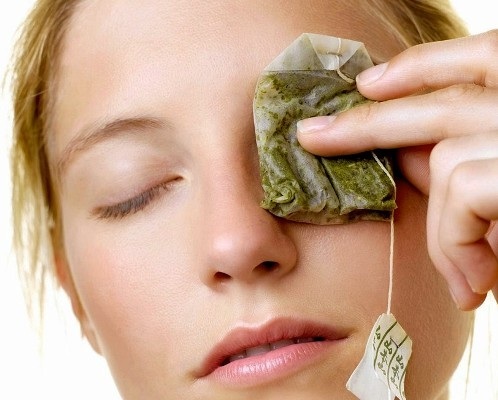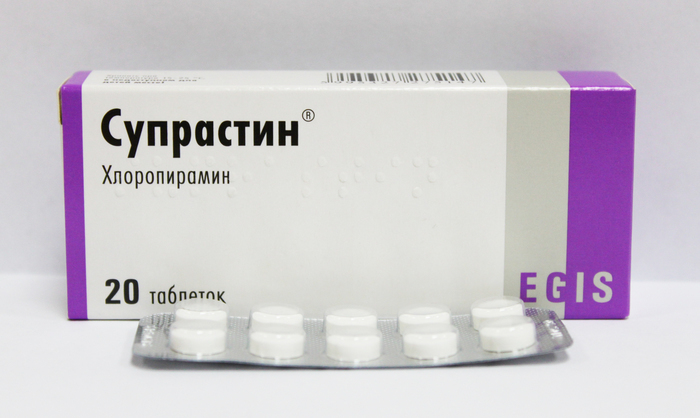Production of liquid secretion from the eyes is a protective reaction of the body to foreign elements (dust, wind, villi, bright light). Lacrimation in its natural manifestation washes the eyeballs and mucous membranes, preventing them from drying out and multiplying bacteria, while helping to remove foreign bodies.
If a tear is regularly released from the eyes, this means the presence of a pathological process. The causes of lacrimation can be different, and the treatment of the problem depends on many factors (age of the patient, underlying cause, accompanying symptoms).
Record content:
- 1 Why is increased lacrimation dangerous?
-
2 Causes
- 2.1 In children
- 2.2 Age
- 3 Lachrymation in the street
- 4 With a cold
- 5 Pain in the eye
- 6 Accompanied by itching
-
7 Treatment
- 7.1 Medication
-
8 Surgical
- 8.1 Folk remedies
- 9 Principles of treating watery eyes in the elderly
- 10 Prevention of lacrimation
- 11 Video about lacrimation
Why is increased lacrimation dangerous?
Lachrymation from the eyes (causes and treatment are interrelated indicators, since therapy is prescribed only after the root cause has been established) in excess can be caused by a number of reasons.
They can be divided into two main groups:
- natural (reaction to any element or provoking factor);
- pathological (increased production of tears appears due to any eye disease).
When lacrimation appears as a natural reaction of the body, you should not worry. Often it helps to get rid of foreign objects that got into the eye and cause discomfort, cramps, pain. The production of liquid secretion occurs in the lacrimal glands, localized in the outer corners of the eyes. The main task of the secret is to moisturize the mucous membrane and protect against the penetration of bacteria.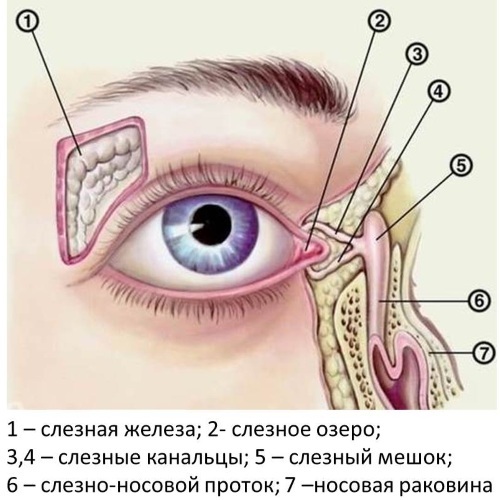
The tear is distributed evenly over the eyeball thanks to the eyelids. Some of the fluid flows to the inner corner, where the lacrimal openings are present, directing to the tear ducts. Through these channels, the tear enters the sac, from where it moves along the nasolacrimal ducts to the nasal cavity.
Normally, the volume of tears produced by additional glands is sufficient to moisturize the mucous membrane of the eyes, while the main gland remains at rest.
However, when exposed to any irritating factor or when a person cries, the gland begins to actively produce a secret, thereby providing additional protection to the eyeballs. That is why, in most cases, lacrimation passes along with the elimination of the irritant.
If any pathological process becomes the cause of increased tear production, in this case, in the absence of adequate treatment, the patient faces irreversible consequences. For example, lacrimation, accompanied by cuts, pains, and gritty eyes, is most likely a sign of glaucoma.
Without treatment, this problem leads to the development of serious complications. First, vision problems appear, and then absolute blindness develops. It is in connection with the risk of loss of vision that you should not neglect the first alarm bells, but you should immediately contact an ophthalmologist and undergo a full examination.
Causes
The causes of watery eyes can be very different, in children it can be some problems, in adults - others. Also, ophthalmologists distinguish 2 types of this problem: retention (obstruction of the tear ducts), hypersecretory (excessive production of tears), and, accordingly, treatment will be prescribed only after receiving the results of diagnostics and setting an accurate diagnosis.
In children
In children, the problem of watery eyes can be caused by a variety of reasons.
This is:
- absolute or partial obstruction of the canals (retention lacrimation), without treatment for which the child expects dacryocystitis;
- insufficiently developed nasolacrimal canal (too narrow);
- respiratory infections (including measles, chickenpox), which lead to swelling of the nasolacrimal passage and, accordingly, to a narrowing of its lumen;
- allergic manifestations, in which obstruction of the lacrimal and nasolacrimal ducts occurs;
- diseases that cause inflammation (keratitis, blepharitis, conjunctivitis with purulent lesions);
- the appearance of teeth in the upper jaw (in young children), often accompanied by an increase in temperature and inflammation of the mucous membranes;
- sudden changes in air temperature, which leads to spasms and swelling of the lacrimal canals;
- eczema of the upper epidermis of the eyelids (additionally manifested by rash, itching, peeling);
- the presence of a foreign element that provokes various unpleasant sensations, including lacrimation;
- eye injuries.
At the age of up to 2 months in children, tears practically do not stand out due to the insufficient development of the lacrimal gland. That is why the increased production of tears at this age should make parents worry, because this may indicate congenital dacryostenosis (abnormal narrowing of the tear ducts).
Age
As a person grows up, the reasons for increased lacrimation become more and more, some of them are the same as in children, but there are also such:
- irritation of the mucous membrane due to provoking factors (wind, dust, foreign bodies, cold, bright lighting);
- allergy;
- inflammation and infections provoked by pathogens;
- abnormal structure of the eyelids (eversion, volvulus), in which proper contact of the lacrimal openings with the lacrimal canals does not occur, respectively, the liquid does not enter the nasolacrimal ducts;
- chronization of rhinitis;
- frequent colds provoke the development of sinusitis (inflammation of the sinuses of the nose);
- dry eye syndrome (a complex pathology that appears due to a decrease in the quality and quantity of tears that form a moist film on the surface of the apple that protects the eyes from various irritants);
- poor-quality contact lens care, inadequate hygiene;
- ENT pathologies, which more and more often make themselves felt with age;
- sinking of the eyeball, as a result of which the eyelashes begin to irritate the mucous membrane;
- deformation of the lacrimal papilla, provoking a violation of the absorption of tears;
- the use of eye drops that the patient has prescribed for himself;
- atony of the lacrimal ducts;
- overwork.
Lachrymation in the street
Lachrymation from the eyes (the causes and treatment of which are varied and are described in the article) can appear on the street as a physiological phenomenon, that is, a reaction to weather conditions. Moreover, this circumstance is typical for every person.
In winter, the lacrimal ducts narrow, therefore, the tear flow through them is reduced, and as a result, the liquid does not enter the nasolacrimal ducts, but goes out.
If there is a bright sun or strong wind outside, the lacrimal gland begins to actively produce fluid in order to protect the eyes from bright light, dust and drying out of the mucous membrane. Many people with allergies have similar reactions during the flowering period of any plants.
With a cold
When a person is overcome by a cold, the mucous membranes of the eyes and nose swell, the nasolacrimal canal narrows, which prevents the normal outflow of fluid, and tears come out.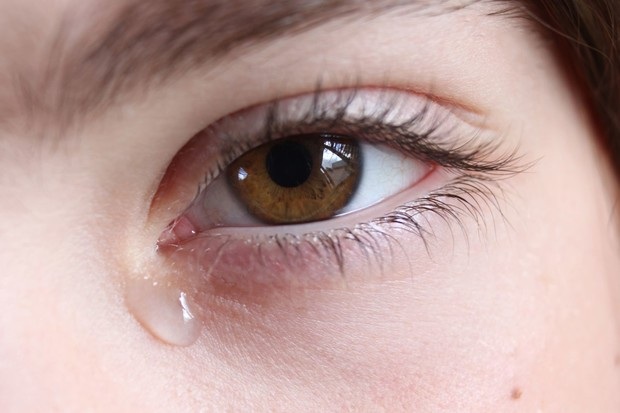
Lacrimation from the eyes with colds can be explained by a viral lesion of the conjunctiva and nasal mucosa. Often, as a result of such exposure, sinusitis and rhinitis develop. Having eliminated these diseases, tearing will go away on its own. In this case, no special treatment for increased tear production is required.
Pain in the eye
Lachrymation from the eyes (the causes and treatment of the condition are interrelated, sometimes simply by eliminating the irritating factor, drug therapy avoidable) is often caused by completely harmless factors - getting into the eye of a speck, eyelashes, villi or any other foreign body.
It is in such situations that a person acutely feels pain. You can get rid of discomfort by removing the irritant.
Along with harmless reasons, pain and lacrimation can be a symptom of any serious illness (conjunctivitis, ulcers, keratitis, uveitis, etc.) or injury. Also, acute pain syndrome is accompanied by injuries and burns.
With common colds, the patient, along with the main symptom of lacrimation, may feel soreness, burning and itching, which are accompanied by swelling and redness of the conjunctiva.
Without thinking that eye pain along with an increased flow of tears can be a completely harmless manifestation, it is better to make an appointment with a doctor. It is strictly forbidden to independently prescribe eye drops, because the consequences can be serious, up to a complete loss of vision.
Accompanied by itching
The appearance of itching along with increased lacrimation often means an allergic manifestation, and sometimes this is possible with colds. Itching can also be felt with conjunctivitis, blepharitis.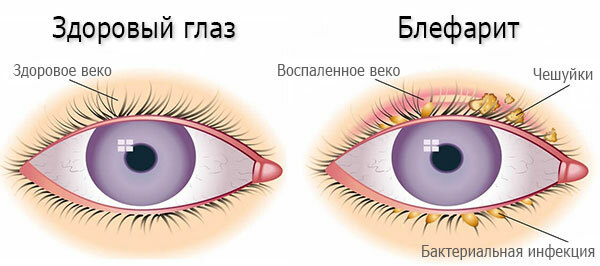
A saprophyte eye mite can settle on the eyelashes and eyebrows of a person, which can cause unbearable itching. Lachrymation in this case appears with frequent and severe scratching of the eyes.
Itching is caused by foreign elements, eye injuries, and corrosive chemicals. Along with itching, pain, redness, and increased lacrimation often appear. If a person starts scratching his eyes, hoping to get rid of unpleasant symptoms, the sensations only intensify, and the situation becomes even worse.
Treatment
Lachrymation from the eyes (the causes and treatment are determined only by the ophthalmologist after the examination) it is treated in several ways: medically, surgically, and alternatively, folk funds. The method and tactics depend on the root cause.
For example, in case of an allergic reaction or if a foreign body gets in, treatment may not be prescribed at all, since the condition can go away on its own.
If lacrimation is caused by fatigue and eye strain, then after a good rest, the discomfort will recede without assistance. With vitamin deficiency, accompanied by lacrimation, healthy and nutritious foods are included in the diet, especially those that contain vitamin B and potassium.
Medication
To eliminate tearing of the eyes, eye drops of various groups are used. The assignment of a particular category depends on the reason.
There are such groups of drops: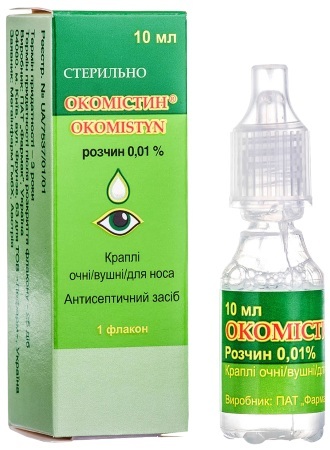
- Antibiotics The drops include antibiotics that eliminate pathogens. Sometimes some antibiotics are prescribed to relieve the inflammatory process, but in such cases, other types of antibacterial drops are combined with these drugs. Among the most widely used antibiotics are Okomistin, Floximed.
- Corticosteroids. This group of drops perfectly relieves acute discomfort in the form of itching, swelling, redness and eliminates severe lacrimation. These drops have a plus - they have practically no side effects and contraindications. The most effective corticosteroids are Paramethasone, Thiotriazolin, Dexamethasone.
- Antiallergic. They are used for allergies. Aimed at eliminating increased lacrimation and the accompanying symptoms (itching, redness, swelling). If an infection develops as a result of an allergic reaction, antibiotics in the form of eye drops are additionally prescribed. Among the effective antiallergic drops, such as Akular, Patanol stand out.
In some situations, physiotherapy is prescribed as a conservative method of therapy, these are:
- massage;
- electrophoresis;
- magnetotherapy.
Surgical
An operable method of treatment is prescribed for patients who are diagnosed with narrowing or absolute obstruction of the lacrimal ducts. Also, indications for surgery are eversion or volvulus of the eyelids, including ptosis of the upper eyelid.
Another reason for the surgical treatment of lacrimation may be the presence of a foreign body that has sunk deep into the mucous membrane and is not able to leave on its own.
To eliminate the problem with the patency of the lacrimal canals, the dacryocystorhinostomy method is used. A probe is inserted into the channels, with the help of which the normal fluid flow is restored.
For ptosis or problems such as eversion and inversion of the eyelids, blepharoplasty is done. Plastic surgery that removes physiological features.
Folk remedies
Traditional medicine can only be effective if combined with drug treatment and when the problem can be resolved without surgery.
Simple phyto recipes that help eliminate tearing, relieve swelling, itching and redness:
| Means | Application |
| Tea brewing | 1. Prepare a strong tea brew, infuse it for 10-15 minutes, then dip a cotton swab into it, then squeeze it slightly. 2. With this tampon, you should blot your eyes with light massaging movements. 3. There should be a separate swab for each eye. |
| Millet broth | 1. Take 2 tbsp. l. millet and pour a glass of cold water over it. 2. Let the composition brew for 1 hour. Drain the infusion. 3. Use cotton swabs to rinse the eyes. The tool allows you to relieve swelling, itching and redness. |
| Aloe infusion | 1. Chop fresh aloe leaves and cover with warm water (ratio 1:10). 2. Let the product brew for 2-3 hours, drain. 3. Use a cotton swab to apply lotions to each eye. |
| Infusion of propolis | 1. Pour the crushed propolis with warm water and let it brew for 2 hours. 2. Strain the product through cheesecloth. 3. Flush eyes with a cotton swab. |
| Dill seed infusion | 1. Take 1 tbsp. l. seeds and pour 1 cup boiling water. 2. Let the product brew for 2 hours, then strain. 3. With infusion, you can wash your eyes and make lotions. |
Herbal medicine can be used only for mild manifestations of lacrimation, not caused by serious diseases. Efficiency is achieved when used together with medications. Before using this or that prescription, you should consult a doctor and conduct an allergy test.
Principles of treating watery eyes in the elderly
As the body ages, the structure of the ducts changes, the muscle tissue weakens, which is why the problem of lacrimation in older people appears many times more often than in young people. In medicine, this condition is called keratoconjunctivitis dry and dry eye syndrome. Despite the increased tear production, there is not enough moisture to hydrate the mucous membrane.
There is an increase in the evaporation of the lacrimal secretion. At the same time, a person begins to feel a burning sensation, itching, eye fatigue, periodic involuntary release of tears. In addition, there may be a feeling of the presence of a foreign object in the eyes, a fear of light and constant discomfort.
The problem that occurs in the elderly is eliminated by the use of such eye drops:
-
Albucid. An antibacterial agent prescribed for keratitis, ulcerative appearances, lacrimation, conjunctivitis and blepharitis.
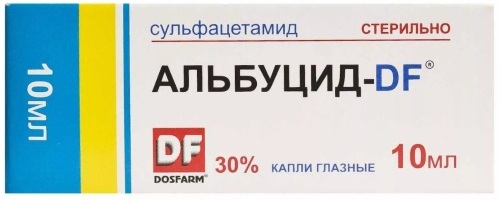
- Opatanol. Antiallergic drug that has no side effects. The tool helps to get rid of burning, itching, redness, swelling.
- Dexamethasone. A corticosteroid used to eliminate symptoms such as swelling, itching, burning, tearing caused by allergies.
Prevention of lacrimation
As a prevention of lacrimation, you should adhere to some recommendations:
- in bright sunlight outside, you should wear sunglasses;
- use only high-quality and proven eye cosmetics;
- when a foreign element enters the mucous membrane of the eye, rinsing should be done, if the element after the procedure remains in the same place, you should contact a specialist to remove it;
- for those who are regularly exposed to high eye strain, it should be done at intervals of 2-3 hours perform special exercises for the eyes, which will unload the optic nerve and restore humidity;
- observe hygiene for contact lenses.
Treatment of lacrimation in children is prescribed only by a doctor; it is strictly not recommended to perform any procedures on your own. Eye problems can be so dangerous that a child can lose sight without adequate help.
If tearing from the eyes appears not only with irritating factors, such as bright light, wind, dust, you should find out the exact pathological cause by passing the examination, and only after receiving its results will the doctor be able to prescribe treatment.
It is categorically not recommended to prescribe drops or other means on your own, because sometimes the problem can be serious and require a surgical approach.
Video about lacrimation
Treatment of lacrimation:

